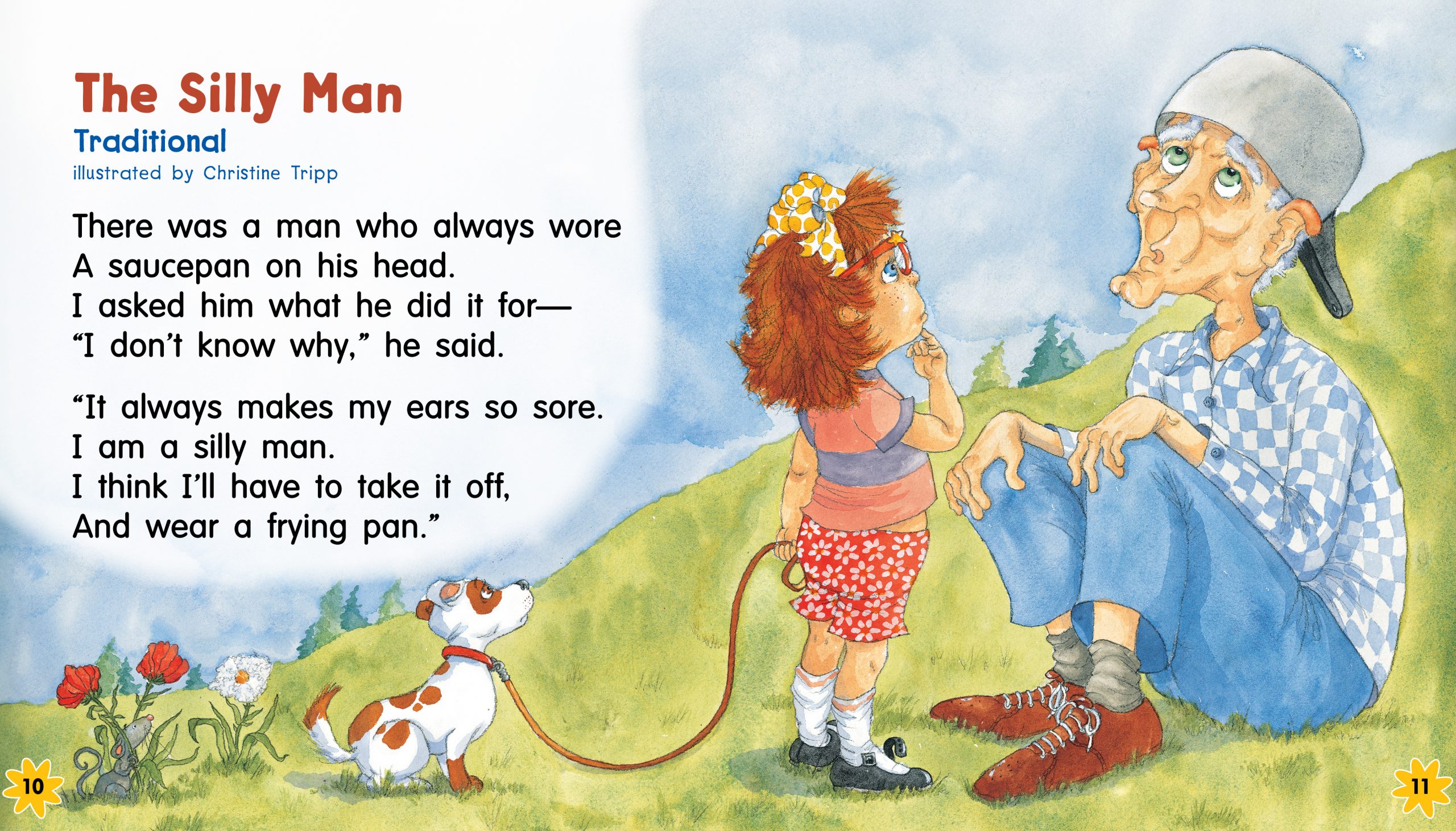Text Type: Fiction: Poetry—rhyming song/poem
Oral Language Teaching Strategy: Role-Play: Explore Other People’s Viewpoints Use role-playing to stimulate social language development and problem solving.
Time: 20 minutes
Materials:
– All Together Now, pages 10–11
– girl puppet
– Media Key or Online: “The Silly Man” audio
Grouping: whole class and partners
Assessment: Kindergarten Oral Language Assessment Scale See especially the sections on Language for Social Relationships and Phonological and Phonemic Awareness.
FIRST READING
BEFORE SINGING AND READING
- Show the students the double-page illustration that accompanies the poem.
- Read the title. Discuss why the person in the illustration might be called a ‘silly man.’ Direct students’ attention to the object on the man’s head and elicit the word ‘saucepan.’
Activating and Building Background Knowledge
Let’s make an expression on our faces like this girl. If you were her, how would you be feeling or what would you say? [Inferring]
- Ask students to look at the expressions on the characters’ faces in the illustration and speculate on how they’re feeling and what they might say to one another. Have students share their ideas with an elbow partner and then ask some students to share with the class.
- As you observe student conversations, listen for socially appropriate language and provide alternatives where necessary.
Harpeet: She’d say his hat looks dumb!
Teacher: The word ‘dumb’ can hurt someone’s feelings. Maybe she could say his hat looks different, instead.
Setting a Purpose
- Explain to students that they should listen to the song and join in as soon as they like. Ask them to think about what the man’s problem is. [Analyzing]
DURING SINGING AND READING
- Play the song and encourage singing along, especially when the song is sung a second and third time.
- Focus on comprehension by offering prompts:
- What is the man wearing on his head? [Analyzing]
- How do you think the man is feeling? [Inferring]
- How do you think the girl is feeling? [Inferring]
- Do you think the frying pan will be a better hat? Why or why not? [Evaluating]
- Is there something the girl could do to help? [Making connections]
- Discuss with students the characters’ feelings. Encourage them to use the illustrations and the text to help explain their ideas. [Inferring]
Joey: He’s sad.
Teacher: Is there something in the pictures or the words that make you think that? - Replay the song and track the print in the big book. As you replay, clap to the rhythm of the song and encourage the students to join in. Explain that there are more words in the song than there are on the pages of the big book because the song has included a chorus that was not part of the original poem. [Phonological awareness]
- Read the song, tracking the print in the big book. Pause at the ends of the lines (the rhyming words) and have students chime in the missing words. [Phonological awareness]
Adding Playful Movements
- Replay the song and add simple actions as suggested by the group. Alternatively, you may follow the suggested actions below:
- There was a man who always wore
A saucepan on his head. (tap head) - I asked him what he did it for—
(tap index finger on chin, as in illustration) - “I don’t know why,” he said.
(shake head no, or turn hands up to the sides) - “It always makes my ears so sore.
(pull on ears) - I am a silly man.
(palms up in front of body) - I think I’ll have to take it off,
(mimic taking saucepan off with one hand) - And wear a frying pan.”
(mimic putting frying pan on with other hand)
- There was a man who always wore
AFTER SINGING AND READING
-
What was the man’s problem in the song? How did he think he could solve his problem? Do you think that sounds like a good solution?
Revisit the purpose for singing and reading by discussing the silly man’s problem with students. [Analyzing]
- Pretend the girl puppet is the girl in the poem. Using the puppet, ask students, “Why are you wearing a saucepan on your head?” and have them choral-read the man’s reply. [Analyzing]
-
Why don’t you have a hat? Where did you get that saucepan? Why do you think a frying pan will be a better hat? I’ll help you look for a new hat. Where would you like to look?
Extend the conversation by using the girl puppet to ask follow-up questions. Invite students to take on the role of the man and share their responses with an elbow partner. Ask a few students to share their ideas. [Inferring/making connections]
SECOND AND FURTHER READING
The students will want to reread and re-sing “The Silly Man.” During further lessons, consider including a balance of ideas from the following areas:
Engaging in Playful Language Activities
- Substitute new objects for the word ‘saucepan’ in the poem (e.g., “There was a man who always wore a bookbag on his head.”). As an extension, for each suggestion, ask students to think of a similar object for the replacement at the end of the song (e.g., bookbag/backpack; apple/orange; mitten/glove). Select one word pairing, and write the replacement words on sticky notes and place them overtop the words in the book. Then sing the words together along with the music-only song track on the Media Key or online.
- Sing or replay the song and have students walk around the classroom or gym, balancing beanbags (saucepans) on their heads.
Extending Comprehension
-
You both took turns and looked at the person talking. I noticed you said, “Please.”
Take on the role of the silly man. Invite students to pretend to be the girl in the song and ask you (the silly man) different questions. Point out appropriate social conventions to use in both the questions and responses (see the Kindergarten Oral Language Assessment Scale—Language for Social Relationships for a list of behaviours), and model these conventions to students (e.g., “Would you please help me look for a new hat?… Thank you.”). Model listening, taking turns, and making eye contact. [Inferring/making connections]
-
Do you think this really happened? Why or why not?
Ask students to speculate on whether the story in the song is true or not.
- Display the digital cloze version of the text on the Media Key. Working with the whole class, or with a small group, reread together and encourage students to supply the missing words (spaces for words highlighted in yellow). You may decide to pause to consider word predictions and prompt, “Does that make sense?” or “Does that sound right?” Then click on the colour-highlighted spot to reveal the word, saying, “Let’s check that out.” An option on the tool bar allows you to create your own cloze versions of the text to meet the needs of the students you are working with. Click on the ‘Help’ button to find out how to use the different features of the digital texts.
Developing Phonological Awareness
- Use percussion instruments (e.g., drums, tambourines, sticks, rattles) to beat out the rhythm of the language and music.
- Clap the syllables in the two-syllable words (‘silly,’ ‘always,’ ‘saucepan,’ ‘frying’).
- Ask students to suggest rhyming words for ‘man/pan’ (e.g., ‘tan,’ ‘ran,’ ‘fan,’ ‘can,’ ‘Dan’), or ‘head/said’ (e.g., ‘bed,’ ‘dead,’ ‘fed,’ ‘led,’ ‘red,’ ‘Ted’).
- Select a word from the song and say it slowly, segmenting it into individual phonemes (e.g., /m/ /a/ /k/ /s/). Have students identify the word (‘makes’), then repeat the process for another word.
Enriching Print Concepts
- Track the print as you read, reread, and sing the song. You may use the girl puppet to reinforce the movement from one line to the next.
- As the song becomes more familiar, ask the students to take turns in tracking the print.
-
I’m thinking of a word in the poem that starts with the same letter as ‘monkey.’ … It has 5 letters.
Select a few words and provide students with clues to guess the word.
- Identify high-frequency words in the poem (e.g., ‘a,’ ‘the,’ ‘I,’ ‘and’) and then use a word frame (e.g., a Wikki Stix bent around the word, a cut-out cardboard frame, or a piece of coloured acetate) to isolate the words. Clap the numbers of letters in each word.
- Locate the words ‘Silly’/‘silly’ and ‘Man’/‘man’ in the title and in the verses of the poem and compare the upper-case/lower-case ‘Ss’ and ‘Mm.’
FOLLOW-UP IN CENTRES
- Place the girl puppet and the big book at a centre and encourage the students to reread the song. Students may use the fluent reading provided on the Media Key or online to support them as they read.
- Students can also re-sing the song with the puppet, using the song on the Media Key or online to provide the music.
- Students can draw or paint pictures of the man wearing another silly object on his head. Encourage students to label or write a short sentence to describe the picture.

